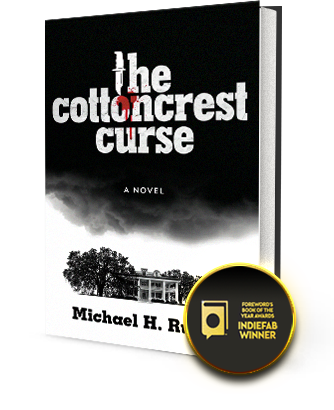Reviews
 Rubin’s gripping debut mystery depicts the bitter racial divides of post-Reconstruction South and its continuing legacy. The story begins in 1893 in Louisiana with the discovery of middle-aged colonel Augustine Chastaine’s corpse sprawled across the mutilated body of his much younger wife, Rebecca, in their home, Cottoncrest Plantation. The evidence seems to indicate murder/suicide; just two more victims of the “Cottoncrest Curse.” Sheriff Raifer Jackson, however, is canny enough to realize that he’s actually looking at a double murder. Unfortunately for Jewish peddler Jake Gold, his religion and acquaintance with the dead couple makes him an ideal scapegoat; even the help of his friends and allies may not be enough to get him out of Louisiana and save him from the rage of the white supremacist Knights of Camellia. . . . Rubin has created a convincing, if unsympathetic, examination of the Old South. Publishers Weekly
Rubin’s gripping debut mystery depicts the bitter racial divides of post-Reconstruction South and its continuing legacy. The story begins in 1893 in Louisiana with the discovery of middle-aged colonel Augustine Chastaine’s corpse sprawled across the mutilated body of his much younger wife, Rebecca, in their home, Cottoncrest Plantation. The evidence seems to indicate murder/suicide; just two more victims of the “Cottoncrest Curse.” Sheriff Raifer Jackson, however, is canny enough to realize that he’s actually looking at a double murder. Unfortunately for Jewish peddler Jake Gold, his religion and acquaintance with the dead couple makes him an ideal scapegoat; even the help of his friends and allies may not be enough to get him out of Louisiana and save him from the rage of the white supremacist Knights of Camellia. . . . Rubin has created a convincing, if unsympathetic, examination of the Old South. Publishers Weekly
 It’s the history woven into the tale that grabbed me most in Michael H. Rubin’s debut novel, The Cottoncrest Curse.
It’s the history woven into the tale that grabbed me most in Michael H. Rubin’s debut novel, The Cottoncrest Curse.
Thoroughly researched, this historical thriller captures the high drama of the Civil Rights Era’s Freedom Riders and Knights of the White Camellia and offers authentic details concerning the harvesting of sugarcane and sharecropping. The novel takes readers on an epic journey from czarist Russia to post-Reconstruction South to Cajun territory in the swamps of Louisiana and the streets of New York City and New Orleans.
Because the novel spans several generations, it contains considerable back story, so the plot doesn’t fly along at the breakneck pace of a traditional thriller. Instead, it meanders through meticulously constructed landscapes of city, country, and bayou in the style of more literary fiction.
On the first page, a docent informs tourists—and readers—that a murder once happened in the antebellum Cottoncrest mansion. The second chapter lapses into the past when the murder took place. The rest of the novel reveals who-dun-it and why with frequent voyages into characters’ pasts.
At the center stands Jake Gold, a peddler who usually tries to hide his identity as an immigrant fleeing from Russia. Jake, a Jew, immediately wins our sympathy because he is so often the victim of prejudice, both abroad and in the States. At the same time, his kindness, intelligence, and lack of pretension earn him friends of all colors and social classes. Jake is accused of murdering an elderly colonel and his comely young wife with one of the razor-sharp knives he sells. But did he? Or did someone else? Or did this married couple become the latest victims of the curse that has plagued the owners of the Cottoncrest plantation?
Sheriff Raifer Jackson aims to find out. He is assisted by a deputy who makes Barney Fife seem brilliant by comparison. A physician and the Knights of the White Camellia also are weapons in the sheriff’s arsenal.
But Jake has his own allies: the many store owners, housewives, and humble citizens he’s sold needles, thread, fabric, and knives to over the years. Adding another layer to the mystery, Jake is not the only one hiding his true identity because of prejudice, but to reveal more would be a plot-spoiler. Surprises abound until the final pages, which reveal this truth: “each of us bears witness only to our own version of the truth, and . . . this incomplete vision blinds us in some way that we can never comprehend.” Southern Literary Review
 The Cottoncrest Curse is a murder mystery set in 1893 in Rouge Parish, Louisiana. A present-day ancestor of Jake Gold, a peddler who lived in 1893, investigates the connection between the owner of the Cottoncrest Plantation’s death and the curse that has involved all who have lived there since. The mystery begins with the deaths of Colonel Judge Augustine Chastaine and his wife in 1893. It was originally thought a murder-suicide, and the Knights of the White Camellia, a racist group of sharecroppers, blamed the death on Jake Gold, a local Jewish peddler. Racism and anti-Semitism abound in this tale.
The Cottoncrest Curse is a murder mystery set in 1893 in Rouge Parish, Louisiana. A present-day ancestor of Jake Gold, a peddler who lived in 1893, investigates the connection between the owner of the Cottoncrest Plantation’s death and the curse that has involved all who have lived there since. The mystery begins with the deaths of Colonel Judge Augustine Chastaine and his wife in 1893. It was originally thought a murder-suicide, and the Knights of the White Camellia, a racist group of sharecroppers, blamed the death on Jake Gold, a local Jewish peddler. Racism and anti-Semitism abound in this tale.
The story line shifts from 1893 to 1961 to the present day, and there are many characters introduced throughout the novel: Jenny, a former slave at Cottoncrest, who takes care of Little Miss, the mother of the murdered owner; Tee Ray Brady and his cast of ruffians in the “KKK-like” gang; the blacks living in Little Jerusalem who fear them; and Hank Mathews, the owner of Cottoncrest in 1961, who eventually kills himself for a mysterious reason.
This is an epic novel of intrigue and racial tensions and a murder mystery set in the Deep South. The characters are fully fleshed out; they are products of their time and location. Tension continues to build until the last page in this absorbing blend of history and mystery. It is a must-read for those who enjoy a novel with a touch of Southern ambiance. Highly recommended. Historical Novel Society
 Racial prejudice drives the action of this historical novel.
Racial prejudice drives the action of this historical novel.
In The Cottoncrest Curse, the debut novel by Michael H. Rubin, an old family curse explains a murder-suicide on a Louisiana sugarcane plantation. The official explanation masks a more commonplace truth: racial prejudice and revenge propel a manhunt for an innocent man.
In the book’s prologue, a docent at an antebellum mansion describes how Colonel Judge Augustine Chastaine of Cottoncrest slit the throat of his beautiful young wife, Rebecca, and then shot himself. It wasn’t the first suicide on the property, and it won’t be the last. The place is cursed.
The local Sheriff isn’t so sure. The murder-suicide doesn’t square with what he knows about the judge or the scene of the crime. But when a trunk of razor-sharp knives is found in the barn, he sends a search party to find Jake, an itinerant Jewish peddler. The three black servants have also disappeared from the mansion, rightly fearing retribution from the racist Knights of the White Camellia. Jake and the servants aren’t guilty, but they know secrets that, if revealed, would threaten a community already teetering on the brink of change.
The novel is told in two time frames: 1893, when the murders take place, and present day, when Jake’s grandson and granddaughter tour the old mansion. Plot twists are plentiful, but the real pleasure of the novel is the historical information woven into the story. From the sharecroppers on the plantation to a village of former slaves, from the Cajun community in the swamps to the Italian immigrants swarming the docks of New Orleans, The Cottoncrest Curse offers a vivid portrait of Louisiana at the end of the 19th Century. The author, a practicing lawyer, has called on his legal background to incorporate issues of hereditary law and early civil rights.
The characters in The Cottoncrest Curse see what they expect to see. A family curse persists because it is easier to believe than the truth, even if the evidence points elsewhere. As Jake’s grandson tells his granddaughter, “Maybe that’s the real curse of Cottoncrest—that we can never know the complete truth, that each of us bears witness only to our own version of the truth, and that this incomplete vision blinds us in some way that we can never comprehend.” The novel rewards readers with an action-packed search, while expanding their understanding of the truth. Foreword Reviews
[ “The Cottoncrest Curse”] weaves a tale through multiple generations and residents of the Cottoncrest Plantation in fictional Petit Rouge Parish. Like most historic south Louisiana homes—or maybe any south Louisiana home, for that matter—this one comes with its fair share of ghost stories. For the Cottoncrest Plantation, it’s all to do with a curse that’s plagued residents for years and brought many to untimely and often gruesome death. One such incident, an apparent murder-suicide, gets pegged on the novel’s central character, Jake Gold, a chameleon of sorts who fled Russia in the late 18oos and wound up peddling wares to the poor Cajuns and former slaves living along the Mississippi River, including pricey German blades he expertly sharpened.
“The Cottoncrest Curse”] weaves a tale through multiple generations and residents of the Cottoncrest Plantation in fictional Petit Rouge Parish. Like most historic south Louisiana homes—or maybe any south Louisiana home, for that matter—this one comes with its fair share of ghost stories. For the Cottoncrest Plantation, it’s all to do with a curse that’s plagued residents for years and brought many to untimely and often gruesome death. One such incident, an apparent murder-suicide, gets pegged on the novel’s central character, Jake Gold, a chameleon of sorts who fled Russia in the late 18oos and wound up peddling wares to the poor Cajuns and former slaves living along the Mississippi River, including pricey German blades he expertly sharpened.
Told in brisk chapters that bounce among multicultural characters, Rubin’s novel is not just a thrilling murder mystery, but also a compelling look at life in South Louisiana during its most tumultuous decades. 225 Magazine
M ichael Rubin’s debut novel, The Cottoncrest Curse, introduces us to a fresh new voice that weaves talented prose and tack-sharp detail into an intriguing story set in Louisiana’s bayou country. In a historically accurate whodunit that spans multiple generations, Rubin adroitly tackles cultural diversity, racial tension, and the dangers of keeping hidden truths while moving the plot toward a satisfying, well-crafted conclusion.
ichael Rubin’s debut novel, The Cottoncrest Curse, introduces us to a fresh new voice that weaves talented prose and tack-sharp detail into an intriguing story set in Louisiana’s bayou country. In a historically accurate whodunit that spans multiple generations, Rubin adroitly tackles cultural diversity, racial tension, and the dangers of keeping hidden truths while moving the plot toward a satisfying, well-crafted conclusion.
Alan Jacobson, U.S.A. Today National Bestselling Author
I n The Cottoncrest Curse, Michael Rubin takes his readers on a compelling multi-generational journey that begins with the Civil War and ends in the present day. The Cottoncrest Curse is a textured story of plantation owners, the descendants of slaves, small-town Louisiana law enforcement, and Jewish merchants who live in and around a stately Louisiana plantation. Impeccably researched, deftly plotted and flawlessly executed, The Cottoncrest Curse moves effortlessly from the Civil War to the 1890s to the Freedom Riders. Michael Rubin is a gifted and masterful storyteller. Highly recommended.
n The Cottoncrest Curse, Michael Rubin takes his readers on a compelling multi-generational journey that begins with the Civil War and ends in the present day. The Cottoncrest Curse is a textured story of plantation owners, the descendants of slaves, small-town Louisiana law enforcement, and Jewish merchants who live in and around a stately Louisiana plantation. Impeccably researched, deftly plotted and flawlessly executed, The Cottoncrest Curse moves effortlessly from the Civil War to the 1890s to the Freedom Riders. Michael Rubin is a gifted and masterful storyteller. Highly recommended.
Sheldon Siegel, New York Times Best Selling Author
 Michael Rubin proves himself to be an exceptional storyteller in his novel The Cottoncrest Curse.’ The powerful epic is expertly composed in both its historical content and beautifully constructed scenery. I highly recommend picking up this book to catch a glimpse into life and conflict during the height of the Old South. James Carville, Author, Media Personality, and Political Commentator
Michael Rubin proves himself to be an exceptional storyteller in his novel The Cottoncrest Curse.’ The powerful epic is expertly composed in both its historical content and beautifully constructed scenery. I highly recommend picking up this book to catch a glimpse into life and conflict during the height of the Old South. James Carville, Author, Media Personality, and Political Commentator
S ometimes, you need a good old-fashioned Southern gothic. If you’re tired of modern novels with no terrible secrets, no mounting dread, and no one screaming into the sultry Louisiana night, pick up The Cottoncrest Curse. This book has it all: a character named Colonel Judge, a dim sheriff’s deputy with dreams of becoming an actor on a riverboat, daring escapes, Cajun and Yiddish proverbs, the Underground Railroad, and a fistfight in a brothel. Like all gothics, the complicated plot takes its time revealing various tangled threads; like the somewhat smaller number of good gothics, the threads all snap tight at the end. So as not to ruin the fun, I’ll leave you with this: the scene where the clumsy deputy drops a severed head is neither the goriest, nor the most shocking, nor the funniest part of the book.
ometimes, you need a good old-fashioned Southern gothic. If you’re tired of modern novels with no terrible secrets, no mounting dread, and no one screaming into the sultry Louisiana night, pick up The Cottoncrest Curse. This book has it all: a character named Colonel Judge, a dim sheriff’s deputy with dreams of becoming an actor on a riverboat, daring escapes, Cajun and Yiddish proverbs, the Underground Railroad, and a fistfight in a brothel. Like all gothics, the complicated plot takes its time revealing various tangled threads; like the somewhat smaller number of good gothics, the threads all snap tight at the end. So as not to ruin the fun, I’ll leave you with this: the scene where the clumsy deputy drops a severed head is neither the goriest, nor the most shocking, nor the funniest part of the book.
Country Roads Magazine
***
 Life in the Old South had its own set of challenges. Racial tensions, cultural diversity, and plantation life were ever present in areas such as the bayou of Louisiana, the setting for Michael Rubin’s debut novel, The Cottoncrest Curse
Life in the Old South had its own set of challenges. Racial tensions, cultural diversity, and plantation life were ever present in areas such as the bayou of Louisiana, the setting for Michael Rubin’s debut novel, The Cottoncrest Curse
He weaves a story that gives us much to think about and includes a number of historically accurate elements, including African American lawyer, Louis Martinet, who was instrumental in challenging the 1896 landmark case, Plessy v. Ferguson, that upheld the constitutionality of state laws that required racial segregation in public areas under the “separate but equal” doctrine.
The story opens with the apparent suicide of Civil War Colonel Augustine Chastaine, who is found on the steps of the Cottoncrest Plantation on top of his young wife, her throat slit. The novel is set across several generations and takes place in modern times, looking back at the story of the Colonel and an apparent suicide two decades after the Civil War. The Colonel’s father had committed suicide at the Plantation at the end of the Civil War. Does a curse exist at the Cottoncrest, or are other factors at work?
One cannot describe the plotlines in greater detail without spoiling it for future readers. Suffice it to say, the story is gripping, the writing is masterful, and is a page-turning thriller that will keep the reader engaged and thinking throughout.
Sheriff Raifer Jackson believes a double homicide has taken place, and itinerant merchant, Jake Gold, is the prime suspect. Rubin then takes the reader on a chase with the Sheriff and his racist deputy. Gold remains a step ahead of the pursuers and he eludes capture. Gold eludes his pursuers while focusing on one final promise he has made. Whatever has happened in the 1893 murder or suicide, owners of the Cottoncrest face continued violence into the 1960s.
Throughout the story, Rubin has the reader contemplating how southern justice was carried out to plantation owners and the descendants of slaves. Rubin beautifully and deftly writes this debut novel and it is apparent he has a deep knowledge of Louisiana, past and present.
The Cottoncrest Curse is highly recommended for its historically accurate portrayal of the south after the Civil War and through the 1960s, as well as for its wonderfully told story. Rubin has struck “gold” in his debut novel. CBA Record (Chicago)
***
 Michael H. Rubin is known in Louisiana and throughout the country as an accomplished attorney and wildly popular CLE presenter. He can now add successful novelist to his list of accolades. His debut novel, The Cottoncrest Curse, is a thrilling mystery that takes the reader on a journey from 1893 to the present day while exploring themes including racial tension and economic inequality that are as relevant today as they were in the post-Civil War era.
Michael H. Rubin is known in Louisiana and throughout the country as an accomplished attorney and wildly popular CLE presenter. He can now add successful novelist to his list of accolades. His debut novel, The Cottoncrest Curse, is a thrilling mystery that takes the reader on a journey from 1893 to the present day while exploring themes including racial tension and economic inequality that are as relevant today as they were in the post-Civil War era.
The story opens with the violent and gruesome deaths of Colonel Judge Augustine Chastaine, an elderly Civil War veteran, and his beautiful young wife, Rebecca, who are found dead on the staircase of their plantation home in Petit Rouge Parish, Louisiana. Many of the local residents – mostly poor white sharecroppers and former slaves – suspect the Colonel Judge and Rebecca were victims of a murder-suicide brought on by the “Cottoncrest Curse,” a rumor that began after the Colonel Judge’s father killed himself at the conclusion of the Civil War. Local Sheriff Raifer Jackson, however, carefully pieces together clues that lead him to believe they were murdered. The sheriff is then persuaded by the leader of a white supremacist group to identify Jake Gold, a Jewish peddler with mysterious ties to the deceased couple, as his main suspect.
Jake, a chameleon-like master of the various languages and dialects spoken by the diverse denizens of the Louisiana bayou, leads a sheriff’s deputy and a group of armed, racist thugs on an exciting chase that culminates on the streets and railways of New Orleans. Interspersed with Jake’s story are chapters set in 1961 and in the present day as Jake’s descendants travel back to Cottoncrest in a quest to uncover the truth of what occurred in 1893.
The book is hard to put down as the reader explores the impact that the deaths of the Colonel Judge and Rebecca had on a colorful cast of characters over the course of more than a century. Also interspersed throughout the novel is the story of Plessy v. Ferguson, the 1896 United States Supreme Court case that upheld the constitutionality of racial segregation laws. Louis Martinet – the African American attorney who orchestrated Homer Plessy’s arrest for violating the Separate Car Act – makes an appearance in the story and provides assistance to Jake and his allies in their attempt to evade capture.
The chapters set in 1961 depict a rural Louisiana still coming to grips with the new reality imposed by Brown v. Board of Education which finally overturned Plessy and declared the state’s “separate but equal” laws unconstitutional.
The themes of racial and economic inequality that Michael H. Rubin explores in The Cottoncrest Curse are as relevant today as they were in 1893 and 1961. One cannot help but compare the stories of police violence against unarmed minorities that permeate the news today with the plight of Jake Gold and the former slaves from the Cottoncrest plantation as they are accused, persecuted and pursued following the plantation owner’s death because of their Jewish heritage or skin color. The exploration of these themes is extremely thought provoking and distinguishes The Cottoncrest Curse from the typical whodunit mystery novel.
The Cottoncrest Curse is well written, meticulously researched, and highly recommended to any fan of the mystery and historical fiction genres. Rhode Island Bar Journal
***
 The Cottoncrest Curse centers around a grisly murder-suicide (or so it appears) which takes place at the Cottoncrest Plantation in Petit Rouge Parish on the west bank of the Mississippi River in 1893. “Whodunit” is the question, of course, and the answer unfolds in short, suspenseful chapters, during which we learn much about the victims, suspects and investigators.
The Cottoncrest Curse centers around a grisly murder-suicide (or so it appears) which takes place at the Cottoncrest Plantation in Petit Rouge Parish on the west bank of the Mississippi River in 1893. “Whodunit” is the question, of course, and the answer unfolds in short, suspenseful chapters, during which we learn much about the victims, suspects and investigators.
Colorful characters abound, from a patrician plantation owner named Colonel Judge Augustine Chastaine to a bumbling sheriff’s deputy named Bucky; from a grizzled Civil War physician named Francois Cailleteau to a savvy and resourceful servant named Jenny; and from a fearless Cajun named Trosclaire Thibodeaux to a multi-lingual immigrant from Czarist Russia named Jake Gold, who must hide his Jewish background during these racist and anti-Semitic times.
I won’t spoil the plot, but trust me: this is a fun read, a page-turner likely to keep you up at night. It is also a historically well-informed book. There are several references to the Battle of Port Hudson in 1863, where Colonel-Judge Chastaine sustained injury. Dr. Cailleteau amputated more than a few Confederate limbs, and the Corps d’Afrique fought valiantly for the Union side. . . . The plight of sharecroppers who are paid poorly and can’t get credit at the plantation store is movingly portrayed. Most importantly, the “passenger car” case of Homer Adolph Plessy v. J.H. Ferguson, which was meant to fulfill the promise of the 14th Amendment but (as we know) wound up setting back the cause of racial justice for generations, plays a key role. Indeed, the book’s climactic scene takes place on one of that train’s Jim Crow cars as it makes its way from New Orleans around Lake Pontchartrain toward Hammond.
No punches are pulled in portraying the racism and anti-Semitism of the times. The Klan-like White Knights of the Camellia “ride” around the parish one terrifying night. Jake Gold’s status as a Jew, when revealed, provokes all kinds of vile, ignorant comments. Mixed into this gumbo, however, is a good dose of comic relief, largely from the aforementioned sheriff’s deputy who wants to be regarded as important but never succeeds. Given its exotic nature, I kept thinking the book would make an outstanding movie — directed, perhaps, by Quentin Tarantino.
As befits any good murder mystery, The Cottoncrest Curse is skillfully and intricately plotted. Its short, punchy chapters, picking up various strands of the plot, sometimes shifting to a different time and place, give you just enough information to wonder what happens next. Eventually, all strands are tied up and secrets are revealed.
Through it all, the writing is sharp, vivid and compelling. Louisiana Bar Journal
***
 The protagonist of The Cottoncrest Curse is Jake Gold, an itinerant peddler and trained shochet (animal slaughterer) who fled Russia as a teenager and who has been making his fortune in the hinterlands of Louisiana selling high quality German knives. Following the brutal deaths of a wealthy plantation owner and his much younger wife, Gold becomes the prime suspect in their killing. The bulk of the book describes the furious manhunt to find him from the points of view of characters from different walks of life whose perspectives are defined by their social caste and limited understanding of the events. It’s a difficult stylistic approach to succeed with, as when it’s not done well, the results can be a muddle for a reader seeking a clear path through a narrative. Rubin pulls it off admirably, especially given the fact that the novel also skips around in time, with events from 1893, 1961, and the present day all figuring in the final resolution of the tale’s mysteries. Berkshire Jewish Journal
The protagonist of The Cottoncrest Curse is Jake Gold, an itinerant peddler and trained shochet (animal slaughterer) who fled Russia as a teenager and who has been making his fortune in the hinterlands of Louisiana selling high quality German knives. Following the brutal deaths of a wealthy plantation owner and his much younger wife, Gold becomes the prime suspect in their killing. The bulk of the book describes the furious manhunt to find him from the points of view of characters from different walks of life whose perspectives are defined by their social caste and limited understanding of the events. It’s a difficult stylistic approach to succeed with, as when it’s not done well, the results can be a muddle for a reader seeking a clear path through a narrative. Rubin pulls it off admirably, especially given the fact that the novel also skips around in time, with events from 1893, 1961, and the present day all figuring in the final resolution of the tale’s mysteries. Berkshire Jewish Journal
***
 “The Cottoncrest Curse” is about the history of Reconstruction in southern Louisiana, set against the backdrop of a mysterious murder. For students of Southern literature, there is plenty of familiar territory here, including the listless collapse of morally bankrupt institutions and the resulting social and economic upheaval. But what sets this novel apart is the lawyer’s eye for less obvious details that shaped these cultural and historical currents.
“The Cottoncrest Curse” is about the history of Reconstruction in southern Louisiana, set against the backdrop of a mysterious murder. For students of Southern literature, there is plenty of familiar territory here, including the listless collapse of morally bankrupt institutions and the resulting social and economic upheaval. But what sets this novel apart is the lawyer’s eye for less obvious details that shaped these cultural and historical currents.
The novel’s protagonist. Jake Gold, is a peddler and Russian-Jewish emigre who is especially drawn to the French-speaking Acadian population. He is the son of a kosher butcher, and, from the opening pages, the recurring ”bloodletting” trope lends a special power to the story.
Not coincidentally, Gold’s principal ware is his Freimer blade, which he sells on credit. But far from embodying passive slaughter, the knives come to represent a kind of incipient modernity, if not outright economic salvation. For Gold, the very act of deal-making-literally consummating the sale-is the glue that binds a delicate and disparate society. (The New Orleans Cotton Exposition, the public rituals surrounding the cochon de lait, and the growth of the railroad all figure prominently into this thoroughly researched background motif.)
Gold’s expansiveness stands in stark contrast to the moral and ethical withdrawal of the Colonel Judge, the nominal white patriarch of the Cottoncrest Plantation and a returning Confederate officer. We never really meet the Colonel, because on the first page we learn that he has apparently murdered his younger wife and committed suicide.
I would be giving too much away if told how Gold becomes ensnared in the murder storyline. The book itself manages to be rewardingly dense, with numerous characters and subplots, and also highly readable.
Mr. Rubin has written an astutely legal-historical novel that is a joy to read and discuss. FBA Advocate
***
A “haunting thriller.” Spines and Covers
***
“Exciting and illuminating.” I Love a Mystery Blog
 A nationally known legal ethicist, public speaker and humorist, as well as a full time appellate attorney,
A nationally known legal ethicist, public speaker and humorist, as well as a full time appellate attorney,
Mike has had a varied career.
©2023 Michael H. Rubin. All rights reserved. Site designed and powered by
Maxmedia Studios








